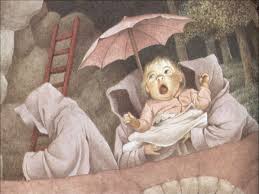The Lindbergh Baby
Listen to the Recess! Clip
| Author | John Cech |
| Air Date | 3/1/2005 |

The Lindbergh Baby Transcript
On March 1, 1932, between 8 and 9 in the evening, someone put a rickety ladder up to the nursery window of the country home in Hopewell, New Jersey, belonging to the most celebrated couple in the world at the time. The kidnapper came down again with the nation’s darling — the “little eagle,” as he was called, the one and a half year old son of the famed aviator, Charles Lindbergh.
About an hour later, Anne Morrow Lindbergh checked on her child, found him missing, and cried out for her husband. A ransom note was discovered on the window sill. A light snow was falling as Lindbergh frantically searched the grounds and then called the police, who descended with the press on the Lindbergh’s secluded home, and launched one of the largest searches in American history to find the child, led in part by retired U.S. General Norman Schwartzkopf’s father, who was then the commanding officer of the New Jersey State Police. Tips soon came pouring in from around the country — indeed, the world — about the whereabouts of the toddler. He was spotted in Latin America; he was seen in the Mid-west with a suspicious couple. Lindbergh, the Lone Eagle, personally flew his own plane, a Fairchild, to check out the leads, and when the kidnappers said in a note that the baby was hidden in a boat off the coast of Massachusetts, Lindbergh scoured the shore in search of him.
In his apartment in Brooklyn, a four-year-old Maurice Sendak was so frightened that the kidnappers would come for him next, that he begged his father to sleep on the floor of his room to protect him. Almost fifty years later, in 1981, Sendak would create a remarkable picture book, Outside Over There, about a baby who is kidnapped by hooded goblins who climb a ladder to his room and spirit him away. The little Lindbergh baby was found, quite by accident, a few months later in the woods just a few miles from his home, and two years later, an immigrant carpenter, Bruno Hoffmann, was brought to trial, convicted, and executed for the crime, the the trial is still clouded with questions. Thousands had shown up every day of the trial in the little town of Flemmington, New Jersey, and outside the courthouse, vendors sold small, souvenir ladders.
In folklore, the heartless job of kidnapping is given to goblins, and there are ways to get your baby back, which have to do with boiling water in an eggshell. In reality, though, as we know, the charms don’t always work. And, as Sendak and countless storytellers have found, the only consolation we have sometimes for these tragedies of life is to rescue the child who has vanished — through art. It is a small consolation that we must cling to, like a straw, like the single delicate filament of a painter’s stippling brush